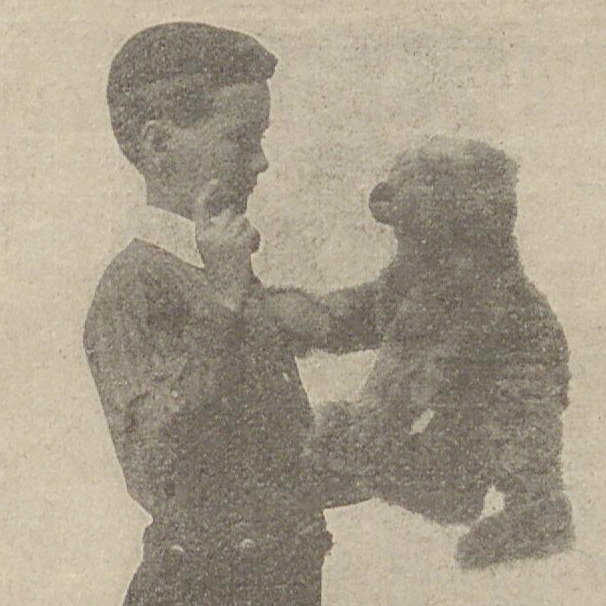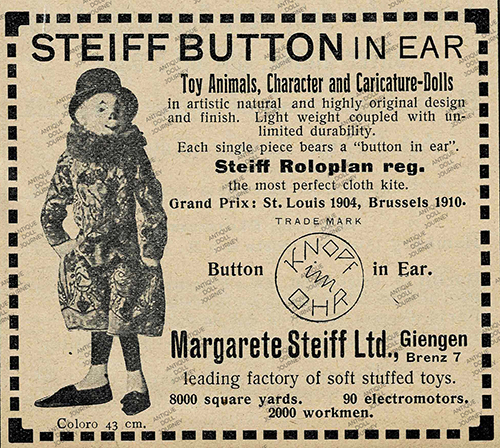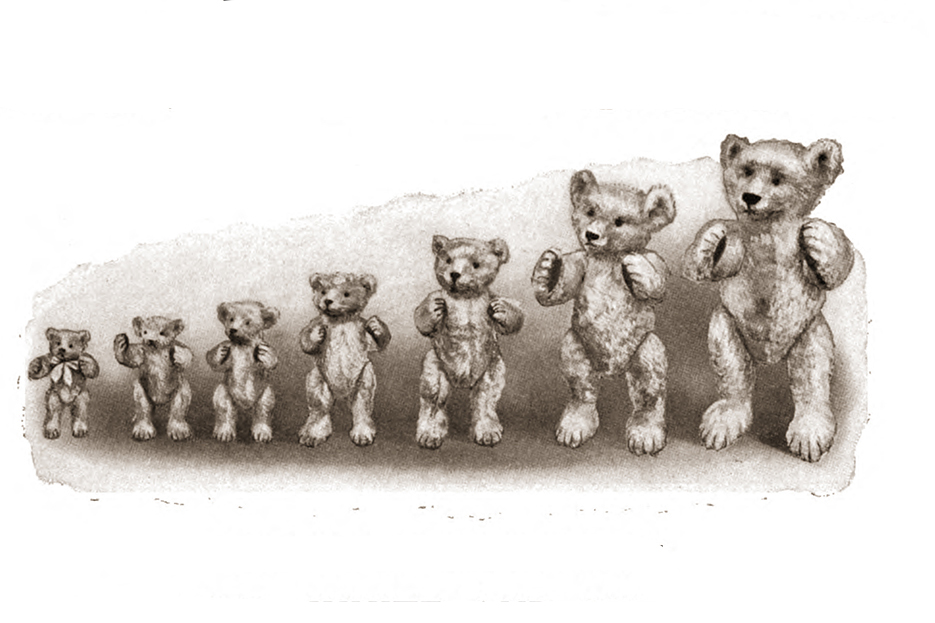Margarete Steiff gained her fame with her stuffed animals and cloth dolls with more focus today on her famous Steiff teddy bears. Her dolls and stuffed animals appeared in the market in the early 1900s alongside cloth dolls by Käthe Kruse and Marion Kaulitz.
Margarete Steiff, Beginnings
Margarete Steiff, a Bavarian dressmaker and paralytic of Geingen of southern Germany founded her company in the late 1800s. The Münchner neueste Nachrichten claims it was in 1888 but Cieslik’s Encyclopedia of German Dolls claims she started in 1877. She had no children of her own but wanted to please the children in her life. Using half a yard of plush and a carton of raw cotton she designed and created a rabbit with a fine, furry, plush body ready for Easter. The rabbit began the Steiff legendary story.
Margarete Steiff, the Dressmaker
Yet an ad from the German newspaper Münchner Neueste Nachrichten (November 13, 1900) tells us of Margarete Steiff’s business making felt dresses or carnival costumes for women and children; as well as room, hall, and pageant decorations. The company advertised mass-produced draperies and claimed three quarters of their sales came from repeat orders.
Leipzig Ads
In the Official Leipzig Trade Fair Addressbook in 1900 a Steiff full page ad features an elephant on a bicycle and a toy dog. The trademark of the elephant on wheels sits at the top right corner of the page. The ad reads, (translated):
MARGARETE STEIFF. GIENGEN a. B.
Telegrams: Felt toys Giengenbrenz. First felt toy factory in Germany. Always selling new products in unbreakable fabric or wool animals, popular due to their durability and amazing load-bearing capacity. Extremely lifelike reproductions of the animal kingdom, in sizes from 8-80 cm and more in height. Sample warehouse in:
Berlin: G. F. Herzog & Co., Stallschreiberstr. 27/28.
Hamburg: John Hess, Alterwall 62.
London: H. E. Hughes, 9 Long Lane E. C.
Paris: Eugène Muller, Rue de Paradis 49.
For the Easter pre-fair in Leipzig: Neumarkt 8, I.”
1902 Leipzig Trade Fair Ad, Ad 2
Germany’s First Felt Toy Factory
The German publication Fliegende Blätter of 1902 claimed the Steiff factory to be the first felt toy factory in Germany and oldest felt mail order store for clothes and decorative felts. The ad gave an address of simply Margarete Steiff, Giengenbrenz. The same ad shared a jointed, movable, unbreakable, softly stuffed Chimpanzee animal toy 60 cm. long, made of plush and felt. In 1906 she had a factory with about 600 workers.
An ad in 1902 in the Leipzig trade fair address book claimed, “
MARGARETE STEIFF. GIENGEN-BRENZ (Württ.).
First felt toy factory in Germany.
Most durable toy of its own invention. 800 famous items, felt, plush, velvet, cuddly, fur, wool and fabric animals. Softly stuffed with iron skeleton, voice and wheels. Most original replica of all existing animals.
Protected novelties 1902/3:
Genuine and lifelike printed wool plush animals; Spitz dogs; felt-covered celluloid tennis balls; many new cradle hangers and rattles; highly original caricature dolls and animals with movable limbs that remain fixed in any position, leather and velvet heads. Made of silk and cotton velvet:
Very small animals, fruits, flowers, insects as knick-knacks, pincushions and dummies.
New detailed, wholesale and export catalogs.
Sample warehouse: Amsterdam, Berlin, Florence, Hamburg, London, Paris, Leipzig, Neumarkt 8 (Easter pre-fair only).”
The factory evidently had giant letters on the roof that pilots in airplanes could read easily from far away. Pilots could use the factory as a landmark.
Maragrete Steiff, Queen of Toyland
Her name was found in various ways in American newspapers from Margarete Steiff, Margaret Steiff, and even Margaret Steiffe. In 1910 a news article called her the “Queen of Toyland.” She produced life-like toys, employed two of her nephews to travel throughout the year in search of new ideas for making attractive toys.
See a full page ad here for STEIFF toys in the December 1909 issue of Fliegende Blätter.
The Famous Teddy Bear
The Daily Morning Journal and Courier of New Haven, Connecticut reported on November 29, 1907 in an toy ad for the Gamble Desmond Co. that Margaret Steiff was the originator of the world famous Teddy Bear three years earlier (1904). The toy department announced they carried the teddy bear in various sizes in white, brown, and cinnamon colors with prices ranging from 75 cents to $5.75. In another similar ad, the department store named Margaret Steiff as the “inventor of his bearship.”

In 1908 newspapers reported that the most famous toy in America was first made by Margarete Steiff of Geingen, Germany, the manufacturer of felt toys. According to the article, it was not until President “Teddy” Roosevelt became the children’s idol that the Teddy bear assumed its wonderfully phenomenal popularity. Other articles claim that the royal family of Germany took up the Steiff teddy bear which influenced its popularity, but not until three years later did it arrive in the USA. The popularity grew so quickly in America that tradesmen who never did more than $10,000 business in the whole list of toys for the year ordered $1,000 worth of bears.
Margarete Steiff at the 1904 St. Louis International Exposition
The International Exposition St. Louis 1904 Official Catalogue of the Exhibition of the German Empire provided a listing for Margarete Steiff on page 445. They listed her as from Glengenbrenz (book’s spelling) and described her as the leading German Felt Toy Factory with stuffed animals and jointed dolls. The animals and dolls came with and without wire frames and some with wheels made of felt, velvet, and woollen stuffs. The listing names Messrs. Paul, Richard, and Franz Steiff, brothers and nephews of Margarete Steiff. They claimed they began exporting in 1900 with a 20% output and increased to a 50% output in 1903. The factory rooms were described as 8,200 sq. metres made of glass and steel.
Later in 1906 the German publication (Deutsches Reich, Reichstag: Verhandlungen des Reichstages or German Empire, Reichstag: Negotiations of the Reichstag) described Steiff’s 1904 exhibition. “Margarete Steiff, Giengen, received the Grand Prix and the Golden Employee Medal for Richard Steiff for her dolls and animals. The exhibition was not very cleverly arranged, but the individual figures were executed in an exemplary manner. Felt is used as the base material. The frame inside gives the figures great strength and, above all, they are completely safe for children as they completely lack sharp edges, wood or metal. The company has therefore achieved significant business success with this innovation. The criticism is that the company often went too far into the grotesque in its attempt to create comical characters. This puts her in strict contrast to Sonneberg.”
Official Leipzig Trade Fair Address Book
1908 Leipzig Ad of Teddy Bear
In 1908 the 24 edition of the Official Addressbook for the Leipzig Trade Fair published a full page ad for Margarete Steiff featuring a photograph of a boy holding a large teddy bear. Under the photo the text translated reads, “Margarete Steiff, G. m. Giengenbrenz wart): Only special factory for unbreakable toy teddy bears and caricature dolls. 2000 workers. 9000 square meters of factory space. 20 electric motors 1/2-6 HP. High performance. Thousands of world-famous patterns based on registered models by technical directors Paul, Richard and Franz Steiff. The significant increase in shipments to all countries of the world and the awarding of the Grand Prix in 1904 prove that Steiff products set the tone. New articulated animals. New caricatures. New baby items. New ball figures. Many improvements. 15 sample warehouses: Berlin SW., Alte Jakobstr. 20, G. F. Hertzog & Co., Hamburg, Neuwall 64, John Hess. Trademark. Every genuine piece has a “button in the ear” on the left. 2.-6. March 1908 in Leipzig as before: Neumarkt 8 Green felt flag.”
Steiff 1909 Patents
Franz Steiff registered a patent (St. 13061) announced in 1909 for a toy with a movable head. Margarete registered (St. 11411) for a soft stuffed toy and another soft stuffed toy with a split claw (St. 11455). Other patents registered as “Margarete Steiff G. m. b. H., Giengen a. Brenz. 5. 2. 09. St. 11360” for a toy with four wheels; and another as St. 11359 for a toy gun. Then patent 11454 for an elephant that could bear water. Patent 11412 was for another soft stuffed toy. She even had a patent for a flying kite, known as the roloplan-kite (11415) and the device for guiding the kites (11564) later improved upon with 11563.
Margarete Steiff’s Button in the Ear
In an article in the German newspaper Münchner Neueste Nachrichten in 1910, a reporter describes how all original Steiff animals and dolls wore the trademarked button in the ear. The article shares an illustration of the round trademark with the German words “Knopf im Ohr” that appeared on the buttons of the toys at that time.
Steiff Toys Pantomime
This same article claimed that the toys had a long life span due to their unbreakability with no mechanics just indestructible washable fun that surpassed the Punch and Judy Show. The Bear and the Chimpanzee could imitate lifelike movements just like puppet animals by rotating the wooden bar in the wrist and moving forward accordingly. Thus the Germans called it the “Pantom-Bär” and the “Pantom-Schimpansen” (chimpanzee), from the idea of imitating the one who pantomimes.

1911 Margarete Steiff Ltd.
Below is an a half page advertisement that appeared in the 1911 Buyer’s Guide Through Germany and Bohemia showing the KNOPF IM OHR circular trademark and name the company as Margarete Steiff Ltd. of Giengen, Gremany. The ad, written in English, describes “toy animals, character and caricature-dolls in artistic natural and highly original design and finish. Light weight coupled with unlimited durability. Each single piece bears a “button in ear.’ Steiff Roloplan reg. the most perfect cloth kite.” Then the ad boasts of the Grand Prix from the 1904 exposition in St. Louis and from Brussels in 1910. They claimed to be the leading factory of soft stuffed toys with 8000 square yards, 90 electromotors, and 2000 workmen. The ad shares an illustration of a toy felt clown of 43 cm.

Steiff Toys in 1913
According to an advertisement from 1913, Steiff’s new line of toys contained animals of all kinds, grotesque little figures and funny fellows. They contained no sawdust or animal hair, and were made of nothing but the cleanest and best materials. The 1913 ad announced teddy bears for sale at price ranges from 50 cents to $2.25. That year the bears came in white, cinnamon, and dark brown. One store’s ad in 1913 claimed they all had a loud growl! They had sizes in 10, 12, 13, 14, 16, 20½, 21, and 25 inches selling from $1.00 to $5.95.
Margarete Steiff 1914 Court Case
1914 court case of Margaret Steiff v Bing related to unfair competition that consisted of imitating the appearance of an article. Newspapers in 1914 reported that Judge Hough (a federal judge) declared that nature cannot be copyrighted and that Miss Steiff copied nature and put it on the market. Manufacturers produced the teddy bear without paying royalties to Steiff and Judge Hough refused to continue the injunction obtained by the heirs of Margaret Steiff.
Steiff vs. Bing, Unlawful Competition
The 1915 issue of the Digest of decisions of the United States Courts liste the case of Steiff vs. Bing. “(U.S.C.C.A.) Description of defendant in the bill as “a citizen of the United States and a resident * * ** of the * * state of New York” is a sufficient statement of his be- ing a citizen of that state.-Margarete Steiff; v. Bing, 206 F. 900, 124 C. C. A. 560.”
Further explanation stated, “(U.S.D.C.) It was no defense to a suit for unlawful competition in the sale of stuffed animal toys manufactured in Germany that defendant’s acts were not violative of the German law. 61. -Margarete Steiff v. Bing, 215 F. 204.”
No Ground for Preventing Competition
The citations continued, “(U.S.D.C.) Unfair competition consists in selling goods by means which shock judicial sensibilities.-Margarete Steiff v. Bing, 215 F. 204. Excellence of a new product or novelty affords no ground for preventing competition unless it is unfair and tends to palm off the goods of defendant for those of complainant.”
What Constituted as Unlawful Competition
More details provided stated, “The borrowing by a newcomer in trade from the first maker of something not necessary to the excellence of the product nor required for functional perfection, but which is calculated to attract and fix the attention of the careless, is what constitutes unlawful competition. -Margarete Steiff v. Bing, 215 F. 204. Where complainant had built up a large business in the manufacture and sale of stuffed animal toys through the use of photographs, etc., defendant, though not entitled to manufacture and sell competing toys made after complainant’s models, was entitled to manufacture and sell such toys manufactured from defendant’s own photographs and models.”
When SAMPLES are Copied
“(U.S.C.C.A) The bill charging that defendant shows prospective customers toys made by complainant as samples of what defendant’s principals manufacture, and it being shown that complainant’s toys are copied by defendant’s principals in unnecessary features, the natural explanation of which is an attempt to impress the public that they are buying complainant’s toys, injunction pendente lite will be granted. – Margarete Steiff v. Bing, 206 F. 900, 124 C. C. A. 560.”
Margarete Steiff V. Gimbel Bros.
“U.S. C. C. A.) Complainant having obtained an injunction restraining B from making and selling stuffed animals after complainant’s models, she was entitled to an injunction restraining defendant from selling such toys purchased from B., until it was established by proof that they had not been copied from complainant’s. -Steiff v. Gimbel Bros., 214 F. 569, 131 C. C. A. 21.”
E.I. Horsman’s Hecla Bear
In 1907 E. I. Horsman manufactured a teddy bear called the Hecla Bear. Manufacturers even in that time had a hard time distinguishing between it and the imported Steiff bear. It ranged in size from 11 inches to 24 inches with a voice box. The ad mentions an 8 inch cinnamon with no voice box.
Images of Early Steiff Dolls
1907 Fabrics, Fancy Goods & Notions
Fabrics, Fancy Goods and Notions published a full page ad in 1907 for the whole family of Steiff Bears in white and cinnamon for the Morgan Importing Co. The ad contained an illustratio of a set of seven bears from the smallest with a bow around his neck to the largest. Sizes ranged from 10 inches to 46 inches with prices of $7.50 to a whopping $126!
from 1909-1910
One can view Steiff dolls from 1909 in fun interactive posed scenes in Dekorative Kunst (click here then zoom in)
from 1913-1914
Dekorative Kunst shares fun illustrations and photographs of the early Steiff dolls in articles about the new popular cloth dolls along side pages with photos of dolls by Käthe Kruse and Marion Kaulitz of Münich. A caption under a fun photo from 1913/1914 of three Steiff doll character’s ice skating mentions Albert Schlopsnies, of Munich, (probably the photographer), Stoff-Puppen and Ausfuhrung: Maragrete Steiff, G. m. b. H., Giengen.
from 1915
Her dolls were posed in military uniforms for photos here in 1914 at the beginning of WWI.
Molly Steiff Dogs
Molly the Steiff dog received full page ads in 1926 in the German Spielwaren-Zeitung and in the magazine Playthings.
1924 Article “Sofftiere”
